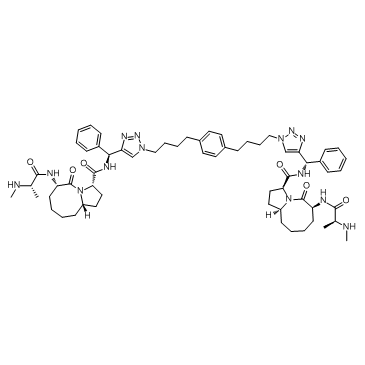All AbMole products are for research use only, cannot be used for human consumption.

In vitro: SM-164 induced complete cIAP-1 degradation, it displayed weak inhibitory effects on the viability of HCC cells. Nevertheless, SM-164 considerably potentiated Apo2 ligand or TNF-related apoptosis-inducing ligand (APO2L/TRAIL)- and Doxorubicin-mediated anticancer activity in HCC cells. Mechanistic studies demonstrated that SM-164 in combination with chemotherapeutic agents resulted in enhanced activation of caspases-9, -3 and cleavage of poly ADP-ribose polymerase (PARP), and also led to decreased AKT activation. Although SM-164 is modestly more effective than SM-122 in induction of cIAP-1/2 degradation, SM-164 is 1,000 times more potent than SM-122 as an inducer of apoptosis in tumor cells, which is attributed to its much higher potency in binding to and antagonizing XIAP. SM-164 radiosensitization in sensitive cells was associated with NF-κB activation and TNFα secretion, followed by activation of caspase-8 and -9, leading to enhanced apoptosis.
In vivo: SM-164 induces rapid cIAP-1 degradation and strong apoptosis in the MDA-MB-231 xenograft tumor tissues and achieves tumor regression, but has no toxicity in normal mouse tissues. SM-164 also radiosensitized human tumor xenograft while causing minimal toxicity.
| Cell Experiment | |
|---|---|
| Cell lines | Breast cancer lines, including SK-BR-3, MDA-MB-468, MDA-MB-453, MCF-7, ZR-75-1, T-47D |
| Preparation method | Cell were seeded in 96-well plates in triplicate and treated the next day with SM-164 in various doses ranging from 0.03 to 10 μM for 24 h. The viability of the cells was then measured using one-step ATPlite cell proliferation assay. |
| Concentrations | 0.03 to 10 μM |
| Incubation time | 24 h |
| Animal Experiment | |
|---|---|
| Animal models | |
| Formulation | |
| Dosages | |
| Administration | |
| Molecular Weight | 1121.42 |
| Formula | C62H84N14O6 |
| CAS Number | 957135-43-2 |
| Solubility (25°C) | 10 mM in DMSO |
| Storage |
Powder -20°C 3 years ; 4°C 2 years In solvent -80°C 6 months ; -20°C 1 month |
| Related IAP Products |
|---|
| AZD5582 dihydrochloride
AZD5582 dihydrochloride is an antagonist of the inhibitor of apoptosis proteins (IAPs), which binds to the BIR3 domains cIAP1, cIAP2, and XIAP with IC50s of 15, 21, and 15 nM, respectively. |
| Sanggenon G
Sanggenon G is a cell-permeable and potent inhibitor of X-linked inhibitor of apoptosis protein (XIAP). |
| TD-1092
TD-1092 is a pan-inhibitor of apoptosis (IAP) degrader with two different types of E3 ligase conjugates, IAP and CRBN, that induces proteasomal degradation of cIAP2 and XIAP in a CRBN-dependent manner. TD1092 also activates apoptotic proteases (apoptosis 3/7) and leads to apoptosis by promoting IAP degradation. In addition, TD1092 also blocks the TNFα-mediated NF-κB signaling pathway and inhibits the phosphorylation of IKK, IkBα, p65, and p38. TD1092 can be used as a PROTAC for cancer research. |
| LBW242
LBW242, a 3-mer and Smac mimetic, is a potent and orally active proapoptotic IAP inhibitor. LBW242 shows effects on mutant FLT3-expressing cells. LBW242 has activity against multiple myeloma, and potentiates TRAIL- and anticancer agent-mediated cell death of ovarian cancer cells. |
| UC-112
UC-112 is a novel potent IAP(Inhibitor of apoptosis) inhibitor. UC-112 potently inhibit cell growth in two human melanoma (A375 and M14) and two human prostate (PC-3 and DU145) cancer cell lines(IC50=0.7-3.4 uM). |
All AbMole products are for research use only, cannot be used for human consumption or veterinary use. We do not provide products or services to individuals. Please comply with the intended use and do not use AbMole products for any other purpose.


Products are for research use only. Not for human use. We do not sell to patients.
© Copyright 2010-2024 AbMole BioScience. All Rights Reserved.
